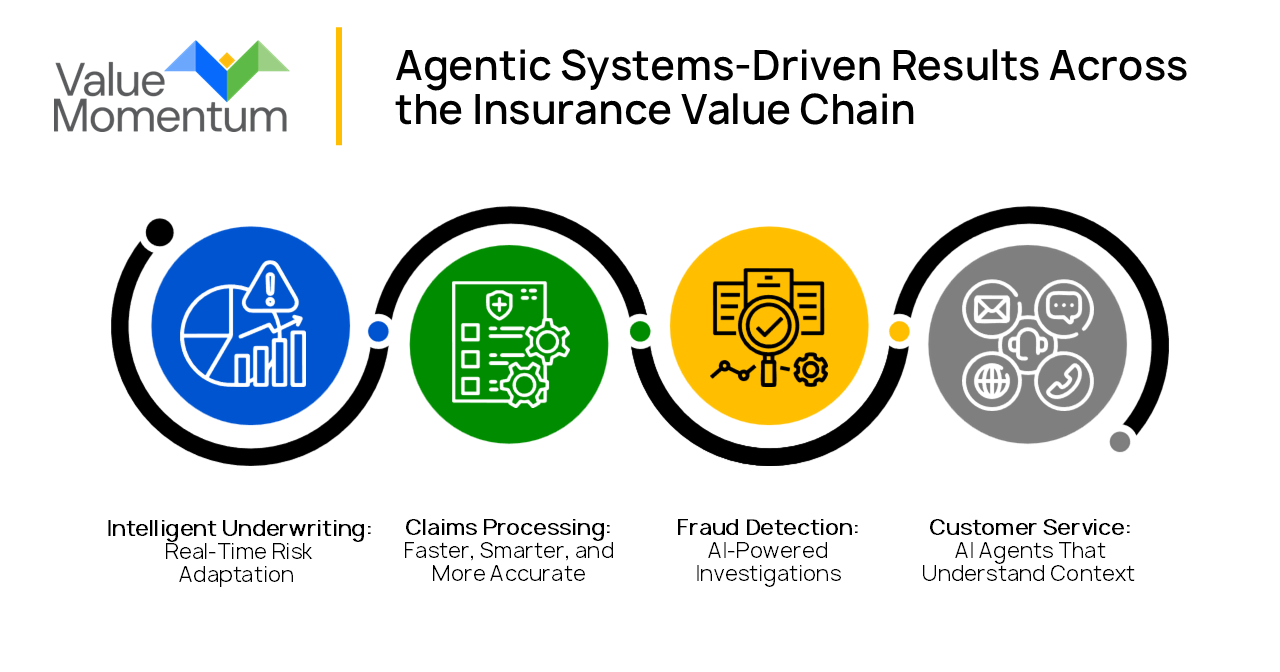The P&C insurance industry is facing unprecedented challenges. The frequency and severity of catastrophic events — from climate-driven disasters to cyberattacks — are both increasing, putting pressure on insurers to reassess their risk models. At the same time, policyholders’ expectations around digital experiences have never been higher thanks to tech giants in other industries, while regulators are demanding greater transparency and accuracy in decision-making.
To stay competitive, insurers must find ways to improve their operations, enhance both internal and external user experiences, and mitigate risks with greater accuracy. While traditional automation has helped carriers boost their efficiency, it lacks the adaptability these organizations need to keep pace with evolving risks and customer expectations.
Enter agentic systems. By integrating artificial intelligence (AI)-driven agents into key processes, insurers can dynamically adjust risk models, expedite claims processing, detect fraud with greater precision, and provide customers with more responsive service.
What Are Agentic Systems?
Agentic systems are autonomous workflows, powered by AI, that go beyond traditional automation by perceiving, reasoning, acting, and learning dynamically. At their core, they integrate technologies such as generative AI, reinforcement learning, multi-agent systems, and large language models (LLMs) to create highly adaptive decision-making frameworks.
While traditional automation has been instrumental in streamlining insurance workflows, its rigid, rule-based nature makes it ill-suited for handling exceptions, edge cases, and emerging risks. Agentic systems, on the other hand, analyze both structured and unstructured data, adjusting their responses dynamically and enhancing efficiency over time.
For example, an agentic underwriting system can assess emerging risk factors instantaneously, incorporating external data sources like climate trends or economic indicators to refine pricing models. Similarly, claims-processing agents can automatically verify policy details, detect potential fraud, and recommend optimal settlement strategies based on historical patterns.
How Agentic Systems Are Reshaping P&C Insurance
As AI adoption accelerates, insurers are seeing measurable gains. AI-driven claims processing has increased cost efficiency by 73%, while fraud detection systems are saving P&C insurers an estimated $1.2 billion annually. But insurers need more than incremental improvements — they need intelligent, adaptive solutions.
Here’s how agentic systems can help insurers drive results across the value chain:

1. Intelligent Underwriting: Real-Time Risk Adaptation
Underwriting has traditionally depended on manual reviews and static risk models, often failing to account for emerging risks such as climate change, cyber threats, or economic shifts. Agentic underwriting systems address these challenges with:
- Real-time data integration, which integrates real-time data from diverse sources, including weather patterns, social media trends, IoT devices, and market fluctuations.
- Dynamic pricing models, which adjust pricing based on new risk indicators, ensuring more accurate and competitive premiums.
- Autonomous anomaly detection, which identifies and flags anomalies without human intervention, allowing for proactive risk management.
For example, after analyzing wildfire activity trends, an AI-driven underwriting system could proactively adjust the price of event insurance policies in affected areas before claims start rolling in.
2. Claims Processing: Faster, Smarter, and More Accurate
Current claims processes often face bottlenecks due to high volumes of paperwork, manual loss verifications, and slow stakeholder communications. Agentic claims systems enhance efficiency by:
- Automated damage assessment: Utilizing computer vision to evaluate vehicle or property damage from images.
- Insight extraction: Employing generative AI to derive insights from claims documents.
- Efficient routing: Coordinating multiple agents to streamline claim routing.
After a hurricane, for instance, an agentic system can automatically analyze aerial imagery to assess property damage, cross-reference claims with policy terms, and initiate digital payments for approved claims without manual intervention. One Nordic insurer using AI-powered claims processing saw a 70% increase in document accuracy rates, significantly reducing manual workloads and accelerating settlements.
3. Fraud Detection: AI-Powered Investigations
Traditional detection methods rely on rule-based systems, which may lead to false positives or missed fraud cases. But by cross-referencing claims data with banking records, location tracking, and even voice analysis, insurers can detect fraud more accurately and reduce financial losses before they escalate. Agentic fraud detection systems improve this with:
- Behavioral pattern analysis: Examining claims history for unusual patterns.
- Data correlation: Cross-referencing multiple data sources, such as banking records and location data.
- Targeted investigations: Initiating in-depth investigations only when necessary.
For example, an insured individual submitted a claim for damages related to inclement weather, including photos of a refrigerator, freezer, and spoiled food. While the photos appeared to support the claim, the AI system flagged them for similarities with images used in three previous claims. A quick desktop investigation confirmed fraud, preventing an unnecessary payout. By identifying repeat fraud patterns instantly, the insurer was able to stop the claim before money changed hands.
4. Customer Service: AI Agents That Understand Context
When Allstate recently tested AI-driven customer communications, the company was not expecting to find that AI-generated responses were more empathetic and less filled with industry jargon than human representatives’ responses, improving customer satisfaction.
With agentic systems, insurance customer service is evolving from basic chatbots to sophisticated AI agents capable of:
- Personalized responses: Providing real-time, policy-specific answers.
- Proactive engagement: Offering recommendations based on individual customer needs.
- Seamless handoffs: Transferring complex queries to human agents when necessary.
By integrating intelligence into underwriting, claims, fraud detection, and customer engagement, agentic systems enable insurers to operate with greater efficiency, accuracy, and responsiveness — ultimately redefining the industry’s approach to risk and policyholder service.
Embrace Agentic Systems’ Competitive Edge
While automation has streamlined insurers’ processes, it lacks the adaptability needed to keep pace with evolving risks and customer expectations. Agentic systems enable insurers to automate complex workflows, enhance decision-making with real-time data, and deliver more intuitive customer experiences.
The future of insurance isn’t just about efficiency — it’s about intelligence and adaptability. And the insurers that act now will be the ones shaping a more resilient, data-driven industry.
To learn more about how insurers can leverage AI to get the most out of their everyday processes, check out our whitepaper The Insurer’s Generative AI Handbook.




